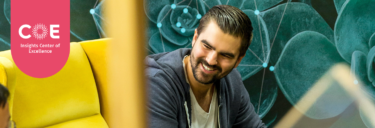
March 25, 2021
Read time: 5min

March 25, 2021
Read time: 5min
In our panel discussion on business impact and scale with insights Centers of Excellence (CoEs), Forrester Principal Analyst Cinny Little shared how CoEs can drive quality decision making with a “hub and spoke” model. She also previewed her new research report, “Deploy These Three Change Agent Personas To Drive More Decision-Making From Data,” which describes how three change agent personas, deployed in existing positions, can turbocharge the necessary transformation that will advance insights-driven maturity.
Cinny identifies three kinds of skills that are critical to achieving more insights-driven maturity: data and/or analytic skills, business skills, and human skills. Human skills, according to Cinny, aren’t sufficiently prioritized by insights organizations. She recommends investing in human skills across organizational silos to change the insights culture, in the form of three change agent personas (who might already exist in every organization!): the evangelist, the catalyst, and the data wrangler.
Our expert panel agreed. Throughout our discussion on insights structures, Brendan Baby, Head of CX, Strategy, & Analytics at The Home Depot, Richard Thorogood VP, Global Head of CMI at Colgate-Palmolive, Phillip Chambers, VP and Global Head of Insights at American Express and Paola Vacchini, Director, Consumer Insights & Analytics Europe at Mondelez, framed their thoughts on insights delivery in terms of the human skills that drive delivery and the need to scale.
Cinny describes evangelists as team leaders who are focused on value delivery through changing ways of working. Their primary objective is to increase the business’s use of data and insights for accountability-based decision making.
They’re typically in a director or VP role, and their insight superpowers include trust-building, resilience, social influencing (up and across the organization), and data storytelling. Their key roles, from an insights perspective, are sponsorship and measurement.
Of course, each of the VPs who joined our panel are clearly world-class evangelists. At The Home Depot, Brendan said his department is determined to “create something that is first and foremost about delivering meaningful useful insights to the business. It’s all about driving business outcomes.”
The centralized structure of his CoE means that the small team spends over half of their time working directly with merchants. It’s the only thing that makes sense in that context, because “there’s no value in delivering that work if it doesn’t actually change some minds.”
Kristina described additional efforts to expand her reach and nurture insights by establishing a “champion community” that encourages increased usage of their Market Logic platform by listening closely to what each unit needs.
At Colgate-Palmolive, Richard emphasized the need for swift delivery when working on initiatives: “you need to demonstrate progress, very quickly, to keep everybody on board and aligned, when you’ve got a sort of fragile alliance around what you’re trying to achieve. And that progress can make the alliance much stronger, and much more powerful.”
Not content with sitting in an ivory tower of insights, Richard said that sharing learning across his federated organization is critical. That’s why he sees the need for strong connections “between the rim and the wheel of the hub, which takes a lot of human skills.” To do so, he emphasizes listening: to “put yourself continually into the shoes of the division, try to find common ground, and make sure that your common ground is aspirational.”
Catalysts serve as “consultants to the business area or areas they’re assigned to,” said Cinny. Their primary objective is to collaborate with business stakeholders to connect specific decision making to the right data and insights. A great example of this is The Home Depot, where the team spends 50% of their time working directly with merchants, understanding exactly what their problem is, knowing what decision they need to make, and then doing the work to inform that specific decision.
“They will not do work unless it leads to an outcome, changes the mind of the recipient, if the results differ from the hypothesis,” shared Brendan. They’re typically in a business analyst role, and their insight superpowers include purpose-driven consulting, collaboration, listening, and data storytelling. Their key role, from an insights perspective, is to act as an interlock between analysts and the business – breaking down silos as they go.
Data wranglers collaborate with catalysts and do much of the heavy lifting required to develop and implement data integration, analytics and visualization that aligns to specific, agreed-upon decision making. They’re typically in a data analyst role, and their insight superpowers include purpose-aligned data munging and visualization, collaboration, and data storytelling. Their key role, from an insights perspective, is to enact data infrastructure initiatives.
In summary, Richard reiterated the need for strong connections “between the rim and the wheel of the hub, which takes a lot of human skills.” At Mondelez, “the beauty of the hybrid CoE model is that you can move people from one organization to another to create the capabilities that are important for them to develop, and to retain talent in your organization.”
That was certainly endorsed by Cinny, who reiterated the need for “more people have to be able to use more data for more insights in decision making – and technology, when it’s connected to the users that need to use it, is a key enabler for that.”
To learn more about how insights CoEs drive business impact, review these organization structures, and this dialogue on insights relevance and differentiation.